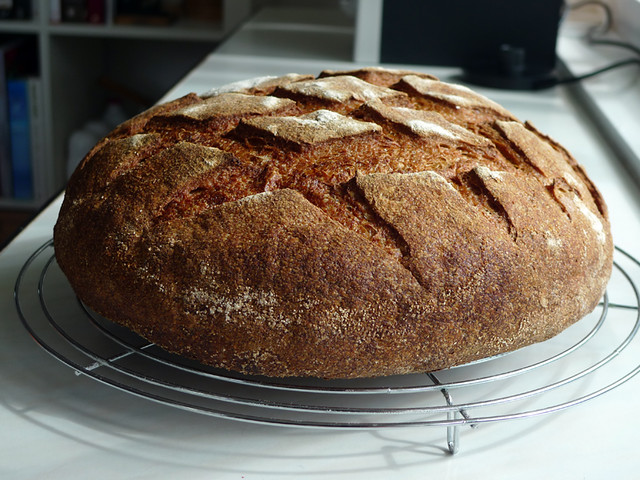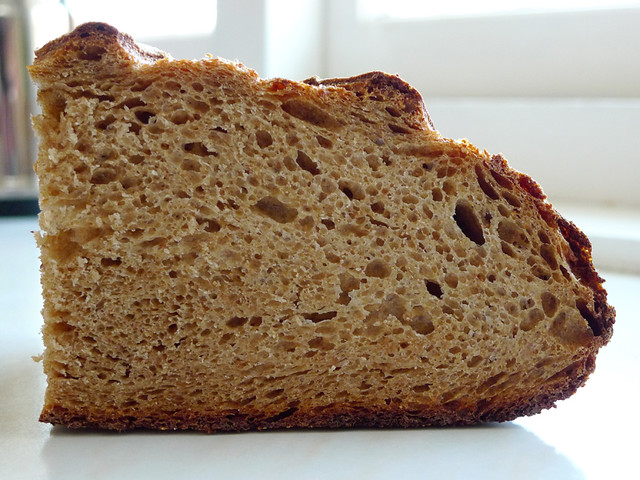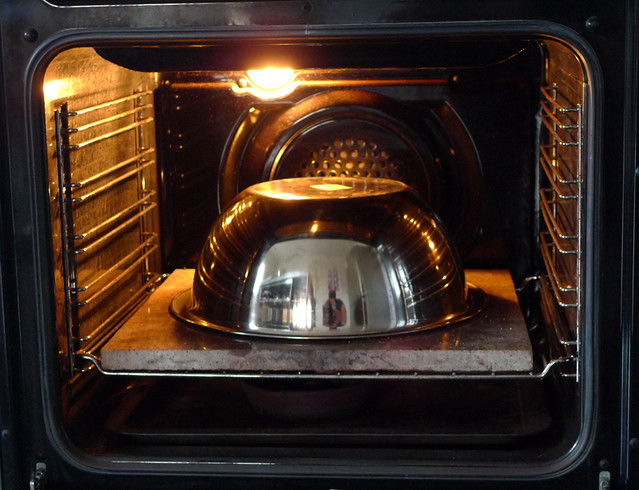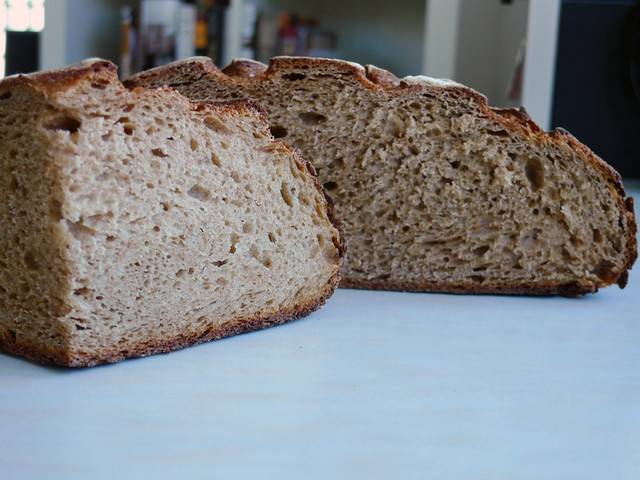 Last Friday I finally returned from my latest trip to China and was eager to try my hand at a rye bread after reading about some interesting ones on The Fresh Loaf. I wanted to make one utilizing a Yeast Water starter per my baking friend DA Brownman who recently baked a master piece using a combination of a Yeast Water starter and traditional SD starter.
Last Friday I finally returned from my latest trip to China and was eager to try my hand at a rye bread after reading about some interesting ones on The Fresh Loaf. I wanted to make one utilizing a Yeast Water starter per my baking friend DA Brownman who recently baked a master piece using a combination of a Yeast Water starter and traditional SD starter.
Since I have been having some fairly successful bakes using coffee in place of the water in my multi-grain bakes I decided to try again and used a simple dark roast coffee for the soaker and for the final dough. I made a soaker using rye berries and cracked wheat. I mixed the hot coffee with the dry ingredients and let sit for 24 hours covered at room temperature.
For the Yeast Water starter I wanted to develop a Pumpernickel starter so I built up the starter in 3 stages. The first stage was left for 4 hours at room temperature and the second stage was left overnight for about 8 hours at room temperature. The final build was left for around 5 hours at room temperature. I tried to make exactly 425 grams of starter, but be sure to weigh your final starter and adjust as needed.
Make sure you drain the grains from the soaker, but be aware that they will absorb a great deal of the liquid. Even though the hydration of this dough is only 70%, it is really much higher when you take the soaker into consideration.
Soaker
485 grams Hot Coffee
100 grams Cracked Wheat
150 grams Malted Rye Berries
Mix coffee in a bowl with other ingredients and let sit covered at room temperature for 24 hours.
Yeast Water Starter Build 1
60 grams Yeast Water
60 grams Pumpernickel Flour
Mix ingredients in a bowl and cover. Let sit at room temperature for 4 hours or until you see some activity and your starter is almost doubled.
Yeast Water Starter Build 2
100 grams Yeast Water
100 grams Pumpernickel Flour
Mix above into starter from Step 1 and let sit covered for 8-10 hours or until the starter has almost doubled.
Yeast Water Starter Build 3
15 grams Yeast Water
100 grams Pumpernickel Flour
Mix above into starter from Step 2 and let sit covered for 4-5 hours or until starter has almost doubled. You can also put in the refrigerator and leave for up to 1 day if necessary until you are ready to bake.
Main Dough
Ingredients
425 grams Starter from above
150 grams Graham Flour (I used Bob's Red Mill)
200 grams White Rye Flour
100 grams Pumpernickel Flour or Dark Rye Flour (I used KAF)
70 grams Roasted Wheat Germ (adds a nice nutty flavor)
370 grams Dark Roast Coffee (90 degrees F.)
14 grams Sea Salt (or table salt)
10 grams Walnut Oil (substitute any oil desired)
Procedure
I mixed the flours together with all the coffee except for 50 grams and let them autolyes for 30 minutes. I then added the Yeast Water Pumpernickel levain, oil and the soaker and the rest of the coffee with the salt and mixed on speed #1 for 1 minute and #2 for 4 minutes. I then did a stretch and fold, rested the dough uncovered for 10 minutes. Note that since this dough was extremely sticky it was not very easy to do a stretch and fold. I then did another stretch and fold, covered the dough and let it rest for 10 minutes. I did one more stretch and fold and put it in a lightly oiled bowl for 2 hours. I then put it in the fridge overnight.
The next day I let the dough sit out at room temperature for 2 hours. I had planned to make 2 boules but since this dough was so moist and did not come together like a bread made with white flour I decided to form it into a large Miche. Alternatively I could have formed it into loaves and baked in a bread or Pullman pan.
Cover the dough in your pans or basket and let it sit at room temperature for 2 hours or until you notice some lift to the dough and it can pass the poke test.
Score the loaves as desired and prepare your oven for baking with steam.

I then baked on my oven stone with steam at 450 degrees until the loaf was golden brown and reached an internal temperature of 200 - 210 degrees F.
I had to bake this bread for almost 50 minutes since it was so moist and the final dough came out with an excellent crust and moist crumb but a little denser than I would have preferred. It is an excellent bread for some sharp cheese and/or a nice grilled cheese sandwich.
This bread has been submitted to Yeast Spotting here at http://www.wildyeastblog.com/




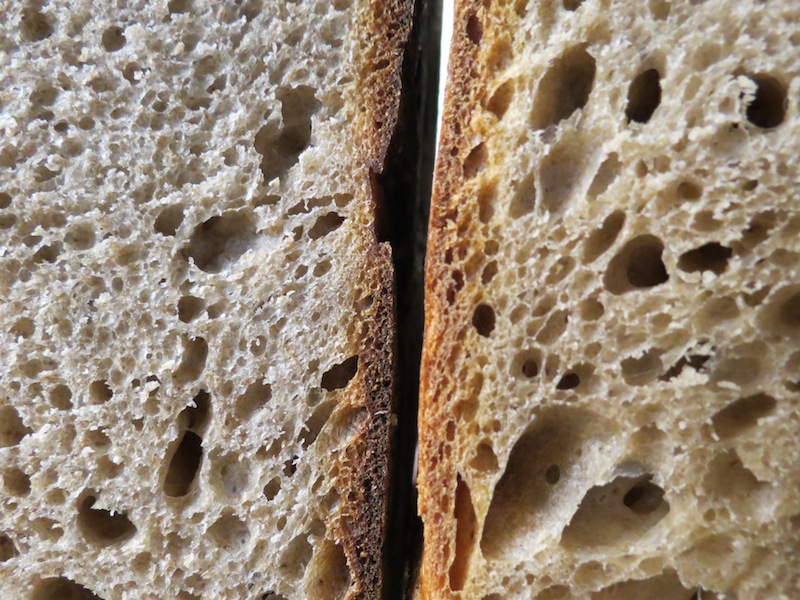 For my second miche taste test I wanted to do two things: compare King Arthur High-Extraction flour against Central Milling Type 85 Malted, and experiment with a smaller loaf after the comment from one of my tasters that the first loaf was "gummy" (though he ended up liking that loaf the best.) Above is a closeup of the result, with the Central Milling loaf on the left.
For my second miche taste test I wanted to do two things: compare King Arthur High-Extraction flour against Central Milling Type 85 Malted, and experiment with a smaller loaf after the comment from one of my tasters that the first loaf was "gummy" (though he ended up liking that loaf the best.) Above is a closeup of the result, with the Central Milling loaf on the left. As you can see, the King Arthur flour has higher ash content which led to a difference in taste that I found distracting (it actually did taste like ash, or chalk, but to a very subtle degree) while others didn't mind it. The crumb turned out great and this 75% formula (producing a loaf that's a bit over 3 lbs vs the 2 Kg full-size miche) is an ideal size for a 5 qt dutch oven if you're using that method.
As you can see, the King Arthur flour has higher ash content which led to a difference in taste that I found distracting (it actually did taste like ash, or chalk, but to a very subtle degree) while others didn't mind it. The crumb turned out great and this 75% formula (producing a loaf that's a bit over 3 lbs vs the 2 Kg full-size miche) is an ideal size for a 5 qt dutch oven if you're using that method.





























